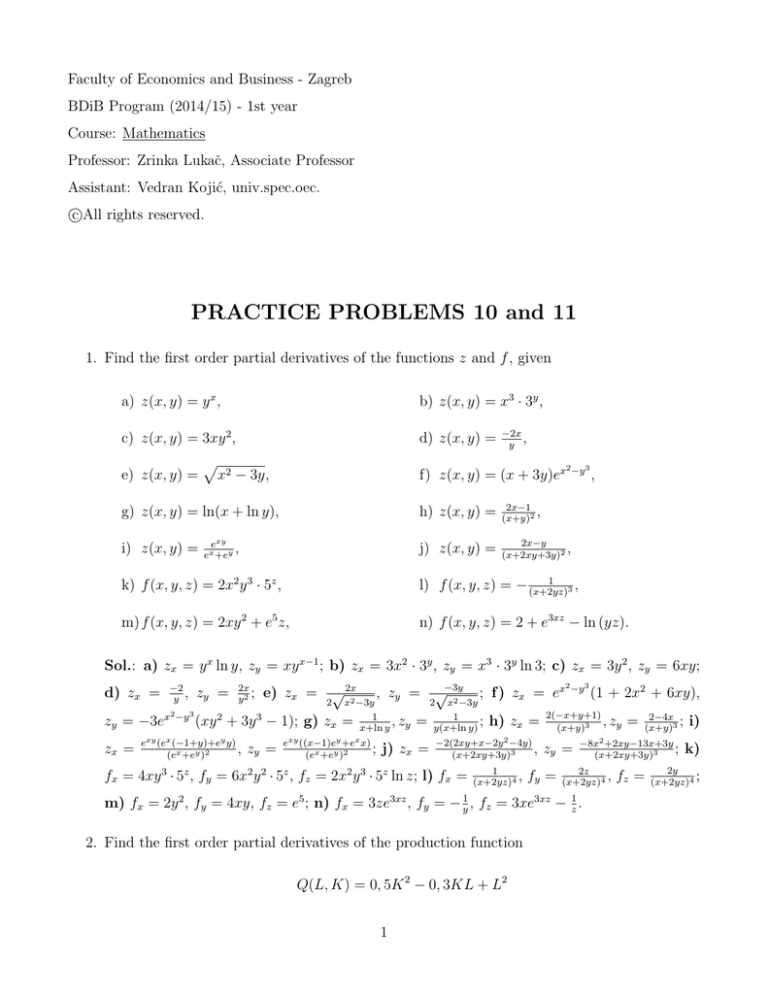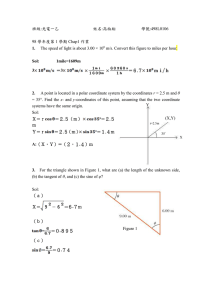
Faculty of Economics and Business - Zagreb
BDiB Program (2014/15) - 1st year
Course: Mathematics
Professor: Zrinka Lukač, Associate Professor
Assistant: Vedran Kojić, univ.spec.oec.
c
All
rights reserved.
PRACTICE PROBLEMS 10 and 11
1. Find the first order partial derivatives of the functions z and f , given
a) z(x, y) = y x ,
b) z(x, y) = x3 · 3y ,
c) z(x, y) = 3xy 2 ,
d) z(x, y) =
e) z(x, y) =
p
f) z(x, y) = (x + 3y)ex
x2 − 3y,
g) z(x, y) = ln(x + ln y),
i) z(x, y) =
−2x
,
y
exy
,
ex +ey
2 −y 3
h) z(x, y) =
2x−1
,
(x+y)2
j) z(x, y) =
2x−y
,
(x+2xy+3y)2
,
k) f (x, y, z) = 2x2 y 3 · 5z ,
1
l) f (x, y, z) = − (x+2yz)
3,
m) f (x, y, z) = 2xy 2 + e5 z,
n) f (x, y, z) = 2 + e3xz − ln (yz).
Sol.: a) zx = y x ln y, zy = xy x−1 ; b) zx = 3x2 · 3y , zy = x3 · 3y ln 3; c) zx = 3y 2 , zy = 6xy;
d) zx =
−2
,
y
zy =
2 −y 3
(xy 2 + 3y 3 −
zy = −3ex
zx =
2x
;
y2
exy (ex (−1+y)+ey y)
,
(ex +ey )2
2
3
, zy = √−3y
; f ) zx = ex −y (1 + 2x2 + 6xy),
x −3y
2 x2 −3y
1
1
2−4x
1); g) zx = x+ln
, zy = y(x+ln
; h) zx = 2(−x+y+1)
, zy = (x+y)
3 ; i)
y
y)
(x+y)3
xy
y
x
2
2 +2xy−13x+3y
e ((x−1)e +e x)
−4y)
; j) zx = −2(2xy+x−2y
, zy = −8x(x+2xy+3y)
; k)
3
(ex +ey )2
(x+2xy+3y)3
e) zx = √ 2x2
zy =
2
fx = 4xy 3 · 5z , fy = 6x2 y 2 · 5z , fz = 2x2 y 3 · 5z ln z; l) fx =
1
,
(x+2yz)4
fy =
2z
,
(x+2yz)4
m) fx = 2y 2 , fy = 4xy, fz = e5 ; n) fx = 3ze3xz , fy = − y1 , fz = 3xe3xz − z1 .
2. Find the first order partial derivatives of the production function
Q(L, K) = 0, 5K 2 − 0, 3KL + L2
1
fz =
2y
;
(x+2yz)4
in the point (10, 20), and give its interpretation.
Sol.: QL (10, 20) = −40. At level L = 10, if L increases by 1 unit, and K does not change
(K = 20), then Q will increase approximately by 14 units. QK (10, 20) = −40. At level
K = 20, if K increases by 1 unit, and L does not change (L = 10), then Q will increase
approximately by 17 units.
3. Find partial elasticities of the functions f and Q, given
a) f (x, y) = 5x y 4 ,
b) f (x, y) = x2 ex y 3 ,
√
c) f (x, y) = (x + 1)e
y
d) f (x, y, z) =
,
e) f (x, y, z) = (3x + y) · 2yz ,
x2 +y
,
z
f) Q(L, K, t) = 5L0,3 K 0,7 et .
√
y
x
,
E
=
; d) Ef,x =
f,y
x+1
2
y(3xz ln 2+yz ln 2+1)
2+y 2 ln 2)
, Ef,z = z(3xy ln3x+y
;
3x+y
Sol.: a) Ef,x = x ln 5, Ef,y = 4; b) Ef,x = x+2, Ef,y = 3; c) Ef,x =
2x2
,
x2 +y
Ef,y =
y
,Ef,z
x2 +y
= −1; e) Ef,x =
3x
,
3x+y
Ef,y =
f ) EQ,L = 0, 3, EQ,K = 0, 7,EQ,t = t;
4. Find partial elasticities of the function f (x, y) =
1
x−y
with respect to the variables x and y.
Give the interpretation for variable levels x = 2 and y = −4. Sol.: Ef,x (2, −4) = 1. At level
x = 2, if x increases by 1% and y does not change (y = −4), then the value of the function f
will increase approximately by 1%; Ef,x (2, −4) = −2. At level y = −4, if y increases by 1%,
and x does not change (x = 2), then the value of the function f will decrease approximately
by 2%.
5. Given the demand function
q1 (p1 , p2 ) = 1, 3 − 0, 5 ln p1 − 0, 2 ln p2 ,
find coefficients of price and cross–price elasticity. Interpret the results!Sol.: Eq1 ,p1 = −0, 5.
Eq1 ,p2 = −0, 2.
6. Given the demand function
q1 (p1 , p2 ) =
30 + 2p2
,
40 + 3p1
find price and cross–price elasticity at levels p1 = 20, p2 = 10. Interpret the results! Are
goods complementary or substitutable?Sol.: Eq1 ,p1 = −3/5. Eq1 ,p2 = 2/5. The goods are
substitutable.
2
7. Given the demand function
q1 (p1 , p2 , p3 ) =
10 √
+ p2 + 0, 8p3 ,
p1
find price and cross-price elasticity at price levels (1, 4, 10), and give interpretation!Sol.:
Eq1 ,p1 = −0, 5. Eq1 ,p2 = 0, 05. Eq1 ,p3 = 0, 4.
8. Compute xfx + yfy if
p
x2 y xy − y 2
√
a) f (x, y) = √
,
x − 2y
3
b) f (x, y) = 30x0,5 y 2 −
2x3
,
y
xy 2
d) f (x, y) = √ ln y.
x
c) f (x, y) = 2 · 10x y 5 ,
√
2
xy
√
x
3
3
b) 2·30x0,5 y 2 − 2xy ; c) 2x·10x ln 10·y 5 +10x+1 ·y 5 ;
√
· (2 ln y + 1) = xy 2 · 32 x ln y + 2 ln y + 1 .
Sol.: Use Euler’s theorem. a)
d) 23 x3/2 y 2 ln y +
2y
xy−y 2
7 x√
√
·
;
2
x− 2y
9. Let Q(L, K) = 20L0,4 K 0,8 be production function. By using Euler’s theorem find LQL +KQK
.Sol.: 1, 2 · 20L0,4 K 0,8 .
10. Let f (x, y, z) = √√x+y+z
√
√ .
x+ y+ z
Find Ef,x + Ef,y + Ef,z . Sol.:3/4.
11. Given the demand function ln q1 (p1 , p2 , p3 ) = ln 110 − 0, 4 ln p1 + 1, 2p2 + 0, 7p3 , find the sum
of the price elasticity and cross-price elasticities.Sol.: 1, 5.
12. Let f (x, y, z) = e2
2t
x+3z
√
.
y
Find parameter t ∈ R such that xfx + yfy + zfz = 0, 5f .Sol.:
t = 0, 5.
√
√
√
t
13. Let ln g(x, y, z) = ln 5 + ln x2 − ln t+1 y − ln t+1 z. Find parameter t ∈ R, t > 0 such that
Eg,x + Eg,y + Eg,z = 1.Sol.: Such parameter t does not exist!
14. Given the demand function q1 (p1 , p2 ) = 100p31 (4p22 − 2p21 )2t , find parameter t ∈ R such that
the sum of the price elasticity and cross-price elasticities equals 7. Sol.: t = 1.
15. Find the derivative y 0 (x) of the function y(x) which is implicitly defined by function F, if:
a) F (x, y) = 8x2 − 5xy + y 3 + ex = 3,
c) F (x, y) = xy 2 +
√
b) F (x, y) = e2xy + 6x = 0,
2x + y = 0,
d) F (x, y) =
3
1 + xy
= 0.
x
x
2xy
Sol.: a) y 0 (x) = − 16x−5y+e
, b) y 0 (x) = − yexe2xy+3 , c) y 0 (x) = −
−5x+3y 2
√
2(y 2 2x+y+1)
√
,
4xy 2x+y+1
d) y 0 (x) =
1
.
x2
16. Find all second order partial derivatives of the function
a) f (x, y) = x2 e3 y,
b) f (x, y) = x3y ,
c) f (x1 , x2 , x3 ) = 2x31 x22 ln x3 ,
d) g(x, y, z) = xey + z 5 .
Sol.: a) fxx = 2e3 y, fxy = fyx = 2e3 x, fyy = 0; b) fxx = 3y(3y − 1)x3y−2 , fxy = fyx =
x3y−1 · (9y ln x + 3), fyy = 9x3y ln2 x; c) fx1 x1 = 12xy 2 ln z, fx1 x2 = fx2 x1 = 12x2 y ln z, fx1 x3 =
f x3 x1 =
6x2 y 2
,
z
fx2 x2 = 4x3 ln z, fx2 x3 = fx3 x2 =
4x3 y
,
z
3 2
fx3 x3 = − 2xz2y ; d) fxx = 0, fxy = fyx = ey ,
fxz = fzx = 0, fyy = xey , fyz = fzy = 0, fzz = 20z 3 ;
17. Find all second order partial derivatives of the function f (x, y) = 2x3 y 2 in the point (1, 4).
Sol.: fxx (1, 4) = 192, fxy (1, 4) = fyx (1, 4) = 48, fyy (1, 4) = 4; ??.
∂2f
∂x2
= fxx = (y − 1)yzxy−2 ,
∂2f
∂x∂y
∂3f
∂z∂y∂x
= fyx = zxy−1 (y ln x + 1),
∂f
∂y
= fy = zxy ln x,
= fxyz = xy−1 (y ln x + 1).
18. Find Hessian matrix for the function f (x, y, z) = 3xy + 5xz + 4yz. Sol.:
0 3 5
H(x, y, z) = 3 0 4 .
5 4 0
19. For the function f (x, y) = (x2 + y + 4)2y find Hessian matrix in the point (−1, 3). Sol.:
H(−1, 3) =
20. Given f (x, y) = ln
1
2
√
y
x
−16 ln 2
(1 + 4 ln 2)16 ln 2
√
find fxx + fxy + fyy .Sol.: f (x, y) = ln
ln y − ln x; fxx + fxy + fyy =
21. Given z(x, y) = ln(x2 + y 2 ) find
1
x2
+0−
−16 ln 2
16
1
2y 2
=
y
x
.
1
√
= ln y − ln x = ln y 2 − ln x =
2y 2 −x2
.
2x2 y 2
∂ 2z ∂ 2z
+
. Sol.:
∂x2 ∂y 2
∂2z
∂x2
+
∂2z
∂y 2
2
2
−y )
= − 2(x
+
(x2 +y 2 )2
2(x2 −y 2 )
(x2 +y 2 )2
= 0.
22. Find all third order partial derivatives for the function z(x, y) = e2x−3y . Sol.: zxxx =
8e2x−3y , zxxy = zxyx = zyxx = −12e2x−3y , zxyy = zyxy = zyyx = 18e2x−3y , zyyy = −27e2x−3y .
23. Find local extrema for the function:
4
a) f (x, y) = 2x2 + 2xy + y 2 − 4x − 8y,
b) f (x, y) = (x − 1)2 + 2y 2 ,
c) f (x, y) = (x − 2)2 + (y + 3)2 + 24,
d) f (x, y) = 6x3 + 3y 2 − 36xy + 10,
e) f (x, y) = 6xy − x3 − y 3 ,
f) f (x, y) = 2y 3 − 31 x3 + 49x − 54y + 12,
g) z(x, y) = ln(x2 + y 2 + xy),
h) z(x, y) = e−x
i) z(x, y) = 2x
2 −2x+y 2
,
j) z(x, y) = (x2 + y + 4)ey ,
,
k) z(x, y) = (2x2 − y)ex−y ,
m) z(x, y) =
2 −2y+y 2
l) z(x, y) =
x2 +1
,
−4x+y 2
2xy
,
−x−y+1
n) z(x, y) = √x−2y+2
.
2
2
x +y +4
Sol.: a) Local minimum (−2, 6), fmin = −20; b) Local minimum (1, 0), fmin = 0; c) Local
minimum (2, −3), fmin = 24; d) Local minimum (12, 72), fmin = −5174; e) Local maximum
(2, 2), fmax = 8; f ) Local maximum (7, −3), fmax = 1046/3, local minimum (−7, 3), fmin =
−974/3; g) There is no extrema; h) There is no extrema; i) Local minimum (1, 0), fmin = 1/2;
j) Local minimum (0, −5), fmin = −1/e5 ; k) Local minimum (1/4, 9/8), fmin = −1/e7/8 ; l)
There is no extrema; m) Local maximum (1, 0), fmax = −1/2; n) Local maximum (2, −4),
√
fmax = 6.
24. Find local extrema of the function:
a) f (x, y) = x4 − 43 x3 − 4x2 + y 4 − 34 y 3 − 4y 2 ,
b) z(x, y) = 2 ln x + 3 ln y2 + ln(12 − x − y).
Sol.: a) Local maximum (0, 0), fmax (0, 0) = 0, local minimum (−1, −1), fmin (−1, −1) =
−10/3, local minimum (2, −1), fmin (2, −1) = −37/3, local minimum (−1, 2), fmin (−1, 2) =
−37/3, local minimum (2, 2), fmin (2, 2) = −64/3; b) Local maximum (4, 6), fmax = ln(864);
25. Given the total costs
T (Q1 , Q2 ) = Q21 + 2Q1 Q2 + 2Q22 − 12Q1 − 20Q2 + 100,
where Q1 and Q2 are production quantities, find the levels of production Q1 and Q2 which
minimizes the total costs. Also, find the value of minimal total costs.Sol.: Q1 = 2, Q2 =
4, Tmin = T (2, 4) = 48.
5
26. Given p1 = 5 i p2 = 180 − 2Q2 ,and the total costs function T (Q1 , Q2 ) = 3Q21 + 4Q22 + 4Q1 Q2 +
10Q1 + 20Q2 + 3, find the level of outputs Q1 and Q2 which maximizes the profit function.
What is the value of the maximal profit?Sol.: Q1 = 2, Q2 = 3, Dmax = D(2, 3) = 15.
27. Given p1 = 90−Q1 i p2 = 20,and the total costs function T (Q1 , Q2 ) = 0, 5Q21 +3Q22 +Q1 Q2 +20,
find the level of outouts Q1 and Q2 which maximizes the profit function. What is the value
of the maximal profit? Sol.: Q1 = 4, Q2 = 12, Dmax = D(2, 3) = 1117.
6



